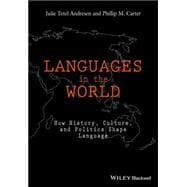This innovative introduction outlines the structure and distribution of the world’s languages, charting their evolution over the past 200,000 years.
- Balances linguistic analysis with socio-historical and political context, offering a cohesive picture of the relationship between language and society
- Provides an interdisciplinary introduction to the study of language by drawing not only on the diverse fields of linguistics (structural, linguist anthropology, historical, sociolinguistics), but also on history, biology, genetics, sociology, and more
- Includes nine detailed language profiles on Kurdish, Arabic, Tibetan, Hawaiian, Vietnamese, Tamil, !Xóõ (Taa), Mongolian, and Quiché
- A companion website offers a host of supplementary materials including, sound files, further exercises, and detailed introductory information for students new to linguistics








